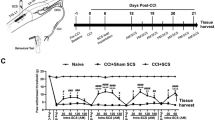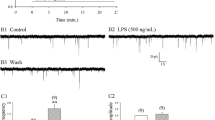Abstract
Our previous results have shown that somatostatin receptor subtype SST2A is responsible for thermal, but not mechanical nociceptive transmission in the rat spinal cord. The present study was undertaken to further examine the ultrastructural localization of SST2A receptor in lamina II of the spinal dorsal horn and the role of SST2A receptor in thermal hyperalgesia following Complete Freund’s Adjuvant (CFA)-induced inflammation. We found that SST2A receptors in lamina II are located primarily in postsynaptic dendrites and soma, but not in axons or synaptic terminals. CFA-induced inflammation markedly increased SST2A receptor-like immunoreactivity in lamina II. Paw withdrawal latency (PWL) evoked by noxious heating was obviously shortened 1 h after intraplantar injection of CFA, exhibiting thermal hyperalgesia. Pre-blocking SST2A activity by intrathecal pre-administration of CYN154806, a broad-spectrum antagonist of SST2 receptor, or specific antiserum against SST2A receptor (anti-SST2A) significantly attenuated thermal hyperalgesia in a dose-dependent fashion in CFA-treated rats. But, administration of anti-SST2A or CYN154806 after CFA treatment had no effect upon thermal hyperalgesia. Intrathecal application of SST2A agonist SOM-14 at different doses prior to CFA treatment did not influence thermal hyperalgesia in inflamed rats, but at a low dose shortened PWL evoked by noxious heating in normal rats. These results suggest that spinal SST2A receptors play a key role in triggering the generation, but not maintenance, of thermal hyperalgesia evoked by CFA-induced inflammation. The up-regulation of SST2A receptors in the spinal cord may be one of the mechanisms underlying inflammation-induced thermal hyperalgesia.





Similar content being viewed by others
Abbreviations
- ANOVA:
-
Analysis of variance
- anti-SST2A :
-
Antiserum against SST2A receptor
- CFA:
-
Complete Freunds’s Adjuvant
- DAB:
-
3,3-diaminobenzidine
- i.t.:
-
Intrathecal
- NGST:
-
Normal goat serum in PBS with Triton X-100
- PB:
-
Phosphate buffer
- PBS:
-
Phosphate buffered saline
- PWL:
-
Paw withdrawal latency
- SOM:
-
Somatostatin
- SOM-LI:
-
SOM-like immunoreactive
- SST:
-
Somatostatin receptor
- SST2A-LI:
-
SST2A receptors-like immunoreactivity
References
Brazeau P, Vale W, Burgus R, Ling N, Butcher M, Rivier J, Guillemin R (1973) Hypothalamic polypeptide that inhibits the secretion of immunoreactive pituitary growth hormone. Science 179:77–79
Johansson O, Hokfelt T, Elde RP (1984) Immunohistochemical distribution of somatostatin-like immunoreactivity in the central nervous system of the adult rat. Neuroscience 13:265–339
Esclapez M, Houser CR (1995) Somatostatin neurons are a subpopulation of GABA neurons in the rat dentate gyrus: evidence from colocalization of pre-prosomatostatin and glutamate decarboxylase messenger RNAs. Neuroscience 64:339–355
Epelbaum J, Dournaud P, Fodor M, Viollet C (1994) The neurobiology of somatostatin. Crit Rev Neurobiol 8:25–44
Yamada Y, Post SR, Wang K, Tager HS, Bell GI, Seino S (1992) Cloning and functional characterization of a family of human and mouse somatostatin receptors expressed in brain, gastrointestinal tract, and kidney. Proc Natl Acad Sci USA 89:251–255
Vanetti M, Kouba M, Wang X, Vogt G, Hollt V (1992) Cloning and expression of a novel mouse somatostatin receptor (SSTR2B). FEBS Lett 311:290–294
Vanetti M, Vogt G, Hollt V (1993) The two isoforms of the mouse somatostatin receptor (mSSTR2A and mSSTR2B) differ in coupling efficiency to adenylate cyclase and in agonist-induced receptor desensitization. FEBS Lett 331:260–266
Hokfelt T, Elde R, Johansson O, Luft R, Arimura A (1975) Immunohistochemical evidence for the presence of somatostatin, a powerful inhibitory peptide, in some primary sensory neurons. Neurosci Lett 1:231–235
Hokfelt T, Elde R, Johansson O, Luft R, Nilsson G, Arimura A (1976) Immunohistochemical evidence for separate populations of somatostatin-containing and substance P-containing primary afferent neurons in the rat. Neuroscience 1:131–136
Nagy JI, Hunt SP, Iversen LL, Emson PC (1981) Biochemical and anatomical observations on the degeneration of peptide-containing primary afferent neurons after neonatal capsaicin. Neuroscience 6:1923–1934
Kummer W, Heym C (1986) Correlation of neuronal size and peptide immunoreactivity in the guinea-pig trigeminal ganglion. Cell Tissue Res 245:657–665
Tuchscherer MM, Seybold VS (1989) A quantitative study of the coexistence of peptides in varicosities within the superficial laminae of the dorsal horn of the rat spinal cord. J Neurosci 9:195–205
Garry MG, Miller KE, Seybold VS (1989) Lumbar dorsal root ganglia of the cat: a quantitative study of peptide immunoreactivity and cell size. J Comp Neurol 284:36–47
Hanesch U, Heppelmann B, Schmidt RF (1995) Somatostatin-like immunoreactivity in primary afferents of the medial articular nerve and colocalization with substance P in the cat. J Comp Neurol 354:345–352
Li CQ, Zhao ZQ, Yang HQ (1991) Effects of cysteamine on flexion reflex facilitation by C-primary afferents in cats. Zhongguo Yao Li Xue Bao 12:199–202
Tuchscherer MM, Seybold VS (1985) Immunohistochemical studies of substance P, cholecystokinin-octapeptide and somatostatin in dorsal root ganglia of the rat. Neuroscience 14:593–605
Wiesenfeld-Hallin Z (1985) Intrathecal somatostatin modulates spinal sensory and reflex mechanisms: behavioral and electrophysiological studies in the rat. Neurosci Lett 62:69–74
Wiesenfeld-Hallin Z (1986) Substance P and somatostatin modulate spinal cord excitability via physiologically different sensory pathways. Brain Res 372:172–175
Ohno H, Kuraishi Y, Minami M, Satoh M (1988) Modality-specific antinociception produced by intrathecal injection of anti-somatostatin antiserum in rats. Brain Res 474:197–200
Traub RJ, Brozoski D (1996) Anti-somatostatin antisera, but neither a somatostatin agonist (octreotide) nor antagonist (CYCAM), attenuates hyperalgesia in the rat. Peptides 17:769–773
Mollenholt P, Post C, Rawal N, Freedman J, Hokfelt T, Paulsson I (1988) Antinociceptive and ‘neurotoxic’ actions of somatostatin in rat spinal cord after intrathecal administration. Pain 32:95–105
Mollenholt P, Post C, Paulsson I, Rawal N (1990) Intrathecal and epidural somatostatin in rats: can antinociception, motor effects and neurotoxicity be separated? Pain 43:363–370
Sandkuhler J, Fu QG, Helmchen C (1990) Spinal somatostatin superfusion in vivo affects activity of cat nociceptive dorsal horn neurons: comparison with spinal morphine. Neuroscience 34:565–576
Fodor M, Slama A, Guillaume V, Videau C, Csaba Z, Oliver C, Epelbaum J (1997) Distribution and pharmacological characterization of somatostatin receptor binding sites in the sheep brain. J Chem Neuroanat 12:175–182
Uhl GR, Tran V, Snyder SH, Martin JB (1985) Somatostatin receptors: distribution in rat central nervous system and human frontal cortex. J Comp Neurol 240:288–304
Ohno H, Kuraishi Y, Nanayama T, Minami M, Kawamura M, Satoh M (1990) Somatostatin is increased in the dorsal root ganglia of adjuvant-inflamed rat. Neurosci Res 8:179–188
Schulz S, Schmidt H, Handel M, Schreff M, Hollt V (1998) Differential distribution of alternatively spliced somatostatin receptor 2 isoforms (sst2A and sst2B) in rat spinal cord. Neurosci Lett 257:37–40
Schulz S, Schreff M, Schmidt H, Handel M, Przewlocki R, Hollt V (1998) Immunocytochemical localization of somatostatin receptor sst2A in the rat spinal cord and dorsal root ganglia. Eur J Neurosci 10:3700–3708
Song P, Hu JY, Zhao ZQ (2002) Spinal somatostatin SSTR2A receptors are preferentially up-regulated and involved in thermonociception but not mechanonociception. Exp Neurol 178:280–287
Zimmermann M (1983) Ethical guidelines for investigations of experimental pain in conscious animals. Pain 16:109–110
Hsu SM, Raine L, Fanger H (1981) Use of avidin–biotin–peroxidase complex (ABC) in immunoperoxidase techniques: a comparison between ABC and unlabeled antibody (PAP) procedures. J Histochem Cytochem 29:577–580
Jensen TS, Smith DF (1982) Role of 5-HT and NA in spinal dopaminergic analgesia. Eur J Pharmacol 86:65–70
Kuraishi Y, Hirota N, Sato Y, Hino Y, Satoh M, Takagi H (1985) Evidence that substance P and somatostatin transmit separate information related to pain in the spinal dorsal horn. Brain Res 325:294–298
Morton CR, Hutchison WD, Hendry IA, Duggan AW (1989) Somatostatin: evidence for a role in thermal nociception. Brain Res 488:89–96
Liu H, Yang HQ, Zhao ZQ (1998) The functional differentiation of substance P and somatostatin in mediating spinal nociception. Chin J Neurosci 14:146–150
Yang HQ, Zhao ZQ, Liu Y (1994) Preferential inhibition of responses of spinal dorsal horn neurons to noxious heat by cysteamine in the cat. Chin J Physiol Sci 10:79–84
Handel M, Schulz S, Stanarius A, Schreff M, Erdtmann-Vourliotis M, Schmidt H, Wolf G, Hollt V (1999) Selective targeting of somatostatin receptor 3 to neuronal cilia. Neuroscience 89:909–926
Gao YJ, Zhang YQ, Zhao ZQ (2003) Involvement of spinal neurokinin-1 receptors in the maintenance but not induction of carrageenan-induced thermal hyperalgesia in the rat. Brain Res Bull 61:587–593
De Felipe C, Herrero JF, O’Brien JA, Palmer JA, Doyle CA, Smith AJ, Laird JM, Belmonte C, Cervero F, Hunt SP (1998) Altered nociception, analgesia and aggression in mice lacking the receptor for substance P. Nature 392:394–397
Acknowledgments
We are grateful to Prof. S. Schulz for the gift of antiserum against SST2A receptor. The work was supported by grants from National Basic Research Program of China Grant (No. 2006CB500807 and 2007CB5125) for Z. Q. Zhao, Postdoctoral Science Foundation of China (1999) and Chinese Academy of Sciences KC Wong Postdoctoral Research Award Fund (2000-the 21st) for Dr. J. Y. Hu.
Author information
Authors and Affiliations
Corresponding author
Additional information
Special issue article in honor of Dr. Ji-Sheng Han.
Jun Zhao and Jiang-Yuan Hu—contributed equally in this paper.
Rights and permissions
About this article
Cite this article
Zhao, J., Hu, JY., Zhang, YQ. et al. Involvement of Spinal Somatostatin Receptor SST2A in Inflammation-Induced Thermal Hyperalgesia: Ultrastructural and Behavioral Studies in Rats. Neurochem Res 33, 2099–2106 (2008). https://doi.org/10.1007/s11064-008-9713-x
Received:
Accepted:
Published:
Issue Date:
DOI: https://doi.org/10.1007/s11064-008-9713-x




